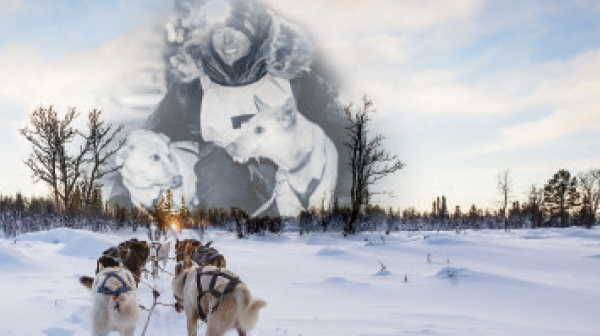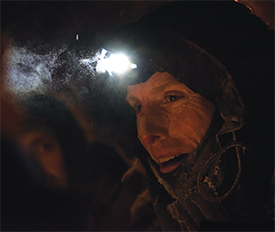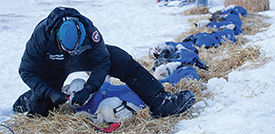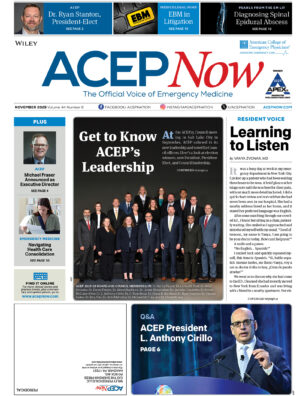
February 17, 2015, Day 10 of the Yukon Quest: rookie musher Damon A. Tedford, MD, Bib #7, and his sled dog team are closing in on their next checkpoint, Two Rivers. “It was just before dawn,” Dr. Tedford said. “We were coming up over a summit and there were four teams ahead of us. It was dark and the night was still with no wind. I started to see signs that we were getting closer to the team in front of us. The dogs probably smelled that team before I could see the headlamp of the musher ahead of us. At one point, we were all working together to get over Rosebud Summit.”
Explore This Issue
ACEP Now: Vol 34 – No 06 – June 2015“He was mastered by the sheer surging of life…expressing itself in movement, flying exultantly under the stars.”
–Jack London, The Call of the Wild
To help the dogs maintain their speed, he ran and pushed the sled rather than standing on the runners. “We were all sweating together, and you could only hear our breaths as we worked to close the distance with the musher ahead of us. It was almost as if we were hunting as a pack,” he said. “It was incredible, a magical experience.”
It’s a thousand miles from Whitehorse to Fairbanks, and during the 10-day Yukon Quest, mushers experience numbing cold, sleep deprivation, and hunger. These are the conditions which Dr. Tedford, an emergency physician at Surrey Memorial Hospital in Vancouver, BC, had been training for since last October. Running the sled dog race in February delivered exactly what Dr. Tedford had hoped it would: the opportunity to challenge himself. From his experiences in the military and as an ultra-marathon runner, he understood that physical challenge leads to a satisfying sense of accomplishment. “When you push yourself to your limit and get to the point where you don’t think you can go any further, you just feel energized by it,” he said.

Dr. Tedford in Dawson. Photo/Pat Kane
His training and determination paid off. At the end of that early morning, six-hour run to Two Rivers, his team overtook the other team. He was on track to secure fourth place and won Rookie of the Year honors.
Attraction to Medicine
Seeking challenge appears to have been a guiding principle in the 37-year-old Dr. Tedford’s career choices as well. He joined the military after high school, graduated from the Royal Military College in Kingston, Ontario, and served five years with the First Battalion of the Princess Patricia’s Canadian Light Infantry. His last deployment, as a light armored vehicle captain, was in 2006 to Kandahar, Afghanistan. “I got into the army because I wanted to help people and I wanted to be challenged,” he said. During his tours in Afghanistan, part of the mission was to form liaisons with local police officers, heads of families, and community power brokers. Where he and other soldiers had difficulty trying to make connections with local populations and authorities, Dr. Tedford observed that medics and physicians were able, “in the blink of an eye,” to establish trust as they came to the aid of locals in need of medical attention. That ability to quickly foster trust was a quality that led him to consider a career in medicine when he finished his military service.

Dr. Tedford in Braeburn. Photo/Pat Kane
Training for the Race
Dr. Tedford’s initial exposure to dog sledding was a one-hour introductory trip run by an adventure company in Algonquin Park, Ontario. The trip was a Christmas present from his partner Lauren Kimball, MD. He was immediately captivated by mushing and resolved to explore the possibility of participating in a full-on endurance run, such as the Iditarod.
Last summer, Dr. Tedford became interested in doing a 1,000 mile endurance sled dog run and contacted Mitch Seavey, a two-time Iditarod champion (who just finished second behind his son Dallas Seavey in the Iditarod on March 18). The three-generation Iditarod family also breeds and trains sled dog teams and leases teams to qualifying mushers. Mitch’s father, Dan Seavey, was the oldest musher, at 74, to run the race on the 40th anniversary in 2012.
Seavey explained that in order to run the Iditarod, Dr. Tedford would have to run several qualifying races and for the 2015 season, there wouldn’t be time. However, entry into the Yukon Quest, he noted, was possible, if Dr. Tedford were willing to run shorter qualifying races. The Yukon Quest began in 1984 (the Iditarod, its renowned counterpart, was first run in 1973). After relocating to Seavey’s kennel in Sterling, Alaska, Dr. Tedford ran in the Gin Gin 200, the Copper Basin 300, and the Northern Lights 300, exceeding the Yukon Quest qualifying requirement to run at least one 200-mile and one 300-mile race. “The qualifying races helped with my confidence level,” Dr. Tedford recalled. “I had no previous racing experience, so it was useful to get out and run the dogs during these qualifying races to see the effectiveness of our training and implement the tempo we planned to run during the Yukon Quest.”

Dr. Tedford at the finish line with his lead dogs Chile (left) and Woody (right).
Photo/Julien Schroder
Working with his leased sled dog team comprised the major portion of Dr. Tedford’s four-month training regimen. Learning to care for the dogs is both essential to bonding with them and a racing requirement—on the race trail, veterinarians examine every dog at the beginning of the race and at six checkpoints to be sure that they are staying healthy.
Dr. Tedford cared for the dogs daily, tending to their feeding and cleaning up their kennel areas. Working with the dogs every day, he said, allowed him to learn more about their individual temperaments. He learned it was necessary to put extra effort into making a connection with the dogs and to “make sure they felt comfortable around me.” While one of the dogs, Bumper, was friendly and extroverted, other shyer dogs needed a bit more attention. Dr. Tedford socialized with these dogs more, bringing them along on errands in the car, or letting them sleep in the cabin with him at night.
Dr. Tedford praised Seavey’s guidance and savvy knowledge about dealing with adult learners. The veteran musher emphasized that Dr. Tedford needed to create a secure environment for the dogs. “That’s essentially what everybody wants, isn’t it? If you can create an environment that’s secure, the dogs will know what’s going on and what’s expected of them,” said Dr. Tedford. “They’re more relaxed. They’re just happier animals, and you sort of fall into that pack structure with them.” Leaving the dogs after the 10-day race, he said, was hard.
Now back at work in Vancouver, Dr. Tedford said it may be a while before he attempts another long distance run, but he is determined to help promote the sport. He reflected that running the race was a peak experience: “At those limits of fatigue, hunger, and even cold, you really just feel charged by it. It’s remarkable to be out there, to see the northern lights and to be with the dog team in areas where no one else is.”
Pages: 1 2 3 4 | Multi-Page






No Responses to “Canadian Emergency Physician Named Rookie Dog Musher in Yukon Quest”